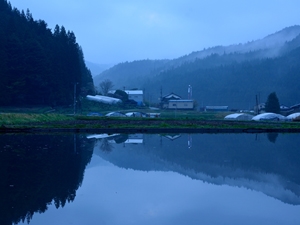The retaining walls making the various levels of terracing are created using rocks, carefully placed in the same way that castle walls were constructed. The amount of time, and labor intensive effort required to build the terraces must have been enormous. This truly is an incredible feat of engineering from 400 years ago.
The narrowest of the fields are just over a meter wide, and there can be over 100 meters difference in elevation between the lowest and highest terraces. Because of the steep levels, differing sizes and irregular shapes, modern machinery can’t be used, and so tending to the fields, planting, reaping and maintenance is all done in the traditional manner, by hand, a time-consuming and laborious job. Rice farming on the terraces is no longer economical at current world markets. Even so, 22 rice farmers continue to till the land, assisted by government subsidies, to produce high quality rice.
The Future of the Fields

Being labor intensive work, the increasing costs of working low yield terraces, the problem of Japan’s graying society and rural depopulation have resulted in the terraces falling into disrepair in recent years. Realizing the value in preserving the paddies and traditional farming practices, as well as the importance of the terraces in water retention and erosion control has lead to the combined efforts of local government and owner adoption systems to revitalize the rice terraces.

The terraced landscapes are enjoyable all year round, with the views changing with the seasons. In late spring the paddies are irrigated for planting, and on a still day depending on your vantage point, mirror the sky, clouds, surrounding hills and forests. By mid summer the rich green of the growing rice is a most refreshing sight. Autumn sees the ripe rice turn a stunning golden yellow, the brightness contrasting with the deep greens of the surrounding trees and mountains. In the winter, the terraces are bare, however, the effort exerted in building and maintaining the hundreds of steps can be more easily appreciated.

Spring is a good time to visit the various Yotsuya Senmaida, as many Rice Planting Festivals are staged by the locals. Dressed in traditional farming wear, the festivals are held right in the rice paddies themselves, with song and dances performed to thank the gods for last year’s crops and pray for a bumper harvest. Locals and visitors alike are encouraged to participate in the planting, so if you don’t mind getting damp and dirty, hop right in and enjoy rural hospitality!

Yotsuya Senmaida is a remote, unique and fascinating scene of traditional farming techniques, developed through a need for land, and greater rice crops. Most of Japan's few remaining Senmaida are located out in the middle of nowhere. Although they are beautiful, they are difficult to both find and get to, facilities are few and far between, they are pretty much unknown and under-appreciated, rarely visited and barely promoted as tourist destinations.
And that's what makes a visit to them so special!



























 Keyword
Keyword









